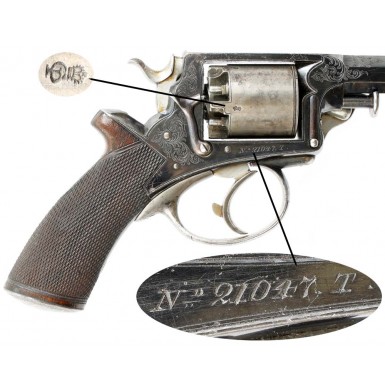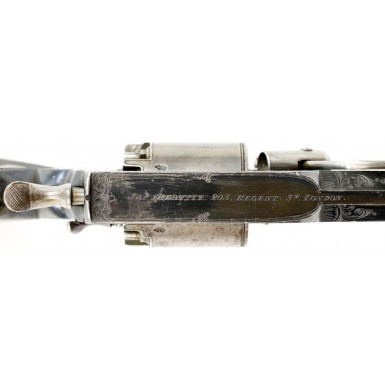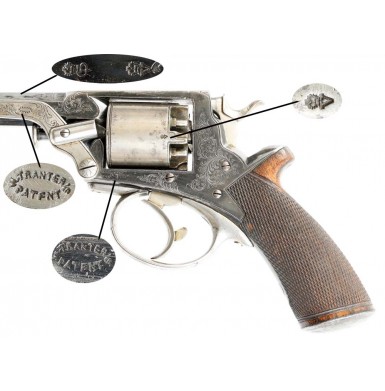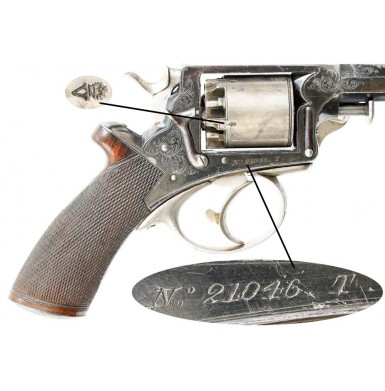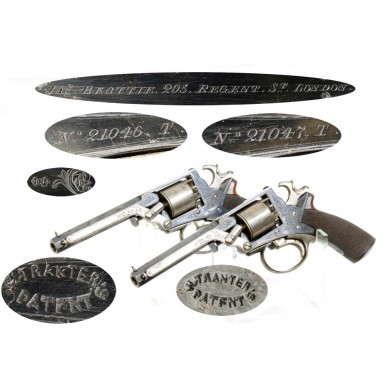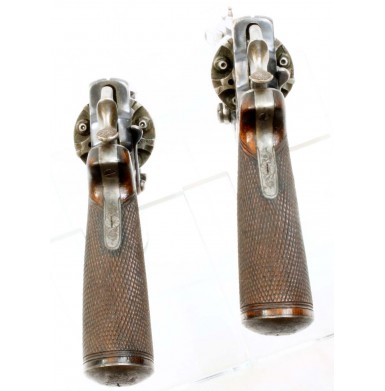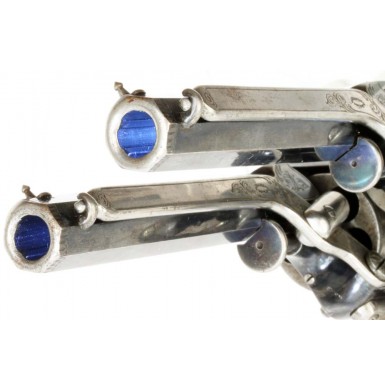Consecutively Numbered Pair of 4th Model Tranter Revolvers
- Product Code: FHG-1862-SOLD
- Availability: Out Of Stock
-
$1.00
The revolvers produced by English gunmaker William Tranter were some of the most advanced and modern handgun designs to see use by the Confederacy during the course of the American Civil War. Tranter was born in 1816 and died in 1890, and during his working life he was one of the most prominent Gun, Rifle & Pistol Makers in the Birmingham (England) gun trade. He went into business for himself circa 1840, after completing his apprenticeship with Hollis Brothers & Co, which he had begun in 1830. Tranter continued in the trade until 1885, just five years before his death. In 1840, after spending a decade learning the gun trade at Hollis Bros & Co (later Hollis & Sheath), Tranter bought the established gun making business of Robert Dugard at 29 ½ Whitehall Street. Over the next decade he worked for himself and was also involved in joint ventures with his old employers John & Isaac Hollis as well as with Isaac Sheath. By 1850 he had located his primary business at 50 Loveday Street, where he was listed in a period directory as having “shops, sheds, steam machinery, yard & premises”. Tranter secured his first British patent related to firearms in October of 1849 when he registered a “pepperbox mechanism and lever catch for pistol locks”. In January 1853 he registered British Patent Number 212 (1853) for a pair of “self-cocking” pistol mechanisms and a safety mechanism. In December of the same year he registered designs for a double-action revolver mechanism, lubricated bullets and wadding, and a breech loading mechanism, all of which were covered by Patent Number 2921 (1853). In August of 1856 he registered the designs for a “double trigger revolver mechanism”, along with several other designs, all of which were covered by British Patent Number 1913 (1856). Tranter continued patenting firearm designs as late as 1887, even though he was no longer directly active in the gun trade.
Tranter’s most successful series of arms were his “self-cocking” revolvers, which were initially introduced in 1853. The earliest revolvers utilized Robert Adams’ patent for a solid, one-piece frame and barrel that were machined from a single forging. Tranter’s initial production run of revolvers included both Adams 1851 Patent lock works, and Tranter's own patented lock works. The original “Tranter” type revolvers, known to collectors as 1st Model Tranter revolvers had no provision for a fixed loading lever. The lever swiveled on a stud that projected from the left side of the frame, which had no provision to retain the lever when it was mounted on the revolver. The lever was intended to be stored in a case or carried in the pocket; hardly a practical solution if the user actually had to reload the revolver in the field. Most of these guns were manufactured on Adams Patent frames and have Adams Patent serial numbers (really patent tracking numbers to pay royalties to Adams) and these numbers are followed by a Y suffix. The 2nd Model Tranterrevolvers also had a pin on the frame that allowed the attachment of a removable loading lever, but the pin had a small projection that allowed the lever to remain attached to the gun unless a notch in the lever was aligned with the stud projection to remove it. The later example of these guns, manufactured after about 1856, have Tranter Patent serial numbers and end with a T suffix. These guns not only include Tranter Patent lock works, but also a newly improved version of the Adams solid frame, which was patented by Tranter in 1856. At this point Tranter revolvers rarely have Adams serial numbers. The 3rd Model Tranter revolvers had a more permanently attached loading lever, which was secured by a screw. The 3rd Models appear to have all been produced in the T suffix Tranter serial number range. All three of these models were based on his “double-trigger” system (initially referred to as his “hesitating mechanism” on the early production guns), which utilized a second “trigger” under the trigger guard to rotate the cylinder and cock the hammer. The trigger inside the triggerguard was used to trip the sear and release the hammer to fire the revolver. The 4th Model Tranter revolvers (which were introduced in 1856 and are all in the Tranter T-suffix series) used a single trigger, and utilized a lock work that would be referred to as a conventional “double action” mechanism today. All of the Tranter revolver patterns were produced in a variety of calibers, with 54-Bore (.442) “Holster Size” and 120-Bore (.338) “Pocket Size” revolvers being the most commonly encountered calibers and frame sizes, and the mid-sized 80-Bore (.387) “Belt Size” being less often encountered. Some of the guns were also produced in the exceptionally large and powerful 36 and 38 bore sizes, which were larger versions of the holster size guns, and were about .50 caliber! Barrel lengths varied as well, with the larger caliber arms typically having longer barrels, and the smaller caliber guns having shorter barrel. All of the guns were 5-shot percussion revolvers, and typically featured checkered one-piece walnut grips, although smooth wooden grips and other grip materials are known to have been used on a special order basis.
The Tranter patent revolver was the primary competitor with the Adams and Adams-Beaumont patent revolvers in England, and was also exported widely. Pre-Civil War Tranter revolvers are known with US retailer marks, indicating that his designs were at least somewhat successful in the United States. The majority of the retailer marked guns are from the southern states, with the largest majority of them being marked by New Orleans retailers. Based upon extant examples, the firm of Hyde & Goodrich (later Thomas, Griswold & Co) appears to have been the primary importer of Tranter Patent revolvers into the southern United States. Most of these retailer marked guns were sold cased with accessories, although some guns were certainly sold without the expensive casings and accouterments. During the course of the American Civil War, it appears that the importation of Tranter revolvers was somewhat limited, at least in terms of Confederate central government purchases. However, period advertisements in the south and extant examples with southern provenance make it clear that the guns were imported by blockade-runners as speculative items for sale in the south. Such famous Confederates as General John Hunt Morgan (3rd Model #3758T), General J.E.B. Stuart (4th Model #8673T), General John Magruder and Colonel Dabney H. Maury (3rd Model #7993T), who served on the staff of General Earl Van Dorn, all owned documented 54-Bore Tranter revolvers. The famous “Pratt Roll”, which lists the revolvers in the possession of Lt. Julian Pratt’s squad of troopers in Company H of the 18th Virginia Cavalry in July of 1864, lists two Tranter revolvers, with the serial numbers 15,465 and 15,476. This indicates that Tranter revolvers in the mid 15,XXX serial number range were in use by southern forces, and in the field by that time. While models are not listed in the list, it is generally assumed that these guns were either 3rd of 4th model revolvers and were likely 54-Bore. Other Tranter revolvers with southern provenance include guns which are retailer marked by T.W. Radcliffe of Columbia, SC. Additionally, a March 10, 1863 advertisement in the Richmond Times Dispatch for H. E. Nichols of Columbia, SC read in part:“Fine English Revolvers. Just received from England, six Tranter’s fine revolving pistols, 80 and 120 bore. Price $220 each”. All of this evidence indicates that at least some of the Tranter revolvers produced during (as well as prior to) the Civil War, saw Confederate use. Dating Tranter revolvers based upon their serial numbers is somewhat problematic, as frames were sometime produced in advance and the guns completed at a later date. What we do know is that the “T” serial number suffix came into use around serial number 2200, sometime between 1854 and 1856. We also know that Tranter produced revolvers using Adams patent serial numbers and a “Y” suffix from about 1853 through about 1856. These guns appear in several serial number ranges, as assigned by Adams, including the 2X,XXX range. All “Y” suffix guns predate the Civil War by at least four or five years. From extant examples of Tranters with specific presentations, dated invoices and dates of usage associated with them, it appears that those Tranter revolvers with serial numbers through about the 20,XXX range (and possibly some of the early guns in the 21,XXX range) with T suffixes appear to have been produced prior to the end of 1865, making them “Civil War era”. Post-Civil War southern retailer marks begin to appear in the 21,XXX range, suggesting that these guns are likely 1865 production, or possibly slightly later.
Offered here are a very scarce consecutively serial numbered pair of 4th Model Tranter Revolvers is in NEAR EXCELLENT condition. They are in the very desirable 54-Bore, which is approximately .442 caliber; equivalent to the Colt “Army” revolver in caliber. The left sides of the frames of both guns are crisply marked with an arced two-line cartouche that: W. TRANTER’S / PATENT. This is located along the lower edge, between the front of the triggerguard and the loading lever mounting screw. The same mark is present on both loading levers as well. The pistols are serial numbered No 21046 T and No 21047 T on the right sides of the frames. Both revolvers are also assembly numbered, with the number 35 appearing on the reverse of the loading lever and back of the cylinder of #21047T and the assembly number 94 appearing in the same places on #21046T. Both revolvers are retailer marked on their top straps: JAs BEATTIE . 203 REGENT STLONDON . James Beattie was an English gunmaker & percussion cap maker who established his initial business in 1832 at 43 Upper Marylebone St. and was listed as the “successor to Collinson Hall”. In 1836 he moved to 52 Upper Marylebone Street, where he remained until 1846. In 1841 he opened an additional location at 223 Regent Street. In 1846 the Upper Marylebone location was closed and Beattie added a second Regent Street location at #205. In 1847 the firm was renamed James & Henry Beattie, Gunmakers. This partnership was short lived, and in 1848 James was back to working under the name James Beattie only, and was only located at 205 Regent Street. In 1864, the company became James Beattie & Son. The firm remained in the Regent Street location through 1879 and then disappears from the directories for two years. In 1881 the company was renamed James Beattie & Company and was listed with premises at 104 Queen Victoria Street. The last directory entry for the firm was 1894. The 1864 name change for the company shed some new light on the discussion above about Tranter serial numbers and their potential dates of manufacture. As the Beattie firm was trading as James Beattie & Son by the end of 1864, it seems likely that these very low serial 21,XXX range Tranter revolvers were probably manufactured during that year as well. Since the retailer mark is engraved on the top straps, it would be very easy to request the guns be engraved with the new business name, unlike the use of a previously existing stamp that would have been expensive to have manufactured.
As noted above, the revolvers is in about VERY FINE to NEAR EXCELLENT condition. The guns are in extremely crisp condition with sharp edges and lines throughout. The guns retain about 85%+ of their original blued finish, with some minor flaking and finish loss from wear along the sharp edges and around the muzzle. The 5 ¾” octagonal barrels bear the expected London commercial view and proof marks of crowned GP and a crowned V the left angled flat, just in front of the frame juncture. The cylinders are also marked with the usual London commercial proof and view marks, alternating between the chambers. The cylinders were case hardened, as were many Tranter and Adams cylinders, and retain about 80%+ coverage of the case coloring. The case coloring has dulled and faded slightly and is slowly starting to “silver out”, but the mottled shapes and coloration remain, and although the coloring is not as vivid as when new, the blues, browns and purples remain in muted tones. The cylinders both retain all of their original cones, and they are all in very crisp and find condition with sharp edges and no significant battering or damage. The bores of the revolver rates about VERY FINE to NEAR EXCELLENT as well, with sharp five-groove rifling. The bores are mostly bright and show only some very lightly scattered pinpricking along their lengths. The metal of both pistols is nearly all smooth and is essentially free of any pitting. Both pistols show some very lightly scattered areas of minute pinpricking, mostly around the chamber mouths, the muzzle and the frame forward of the chamber mouths. There are some small, scattered areas of minor surface oxidation and some lightly scattered traces of minor surface crust on the top straps on both revolvers. Both cylinders also show flecks of lightly oxidized discoloration. The frames, rear of the barrel, triggerguard, loading lever and butt cap are engraved with loose foliate patterns, with about 10%-20% overall coverage. The engraving remains extremely crisp and well defined throughout the pistol and is well executed. Some of the screw heads are lightly embellished with engraving as well. The cylinder shows boarder line engraving at its front and rear, which is also crisp and sharp. The right side of both frames retains their original Tranter’s patent hook safety as well as both of his patented spring catches, which retain the cylinder arbor pins. The safeties are in fine condition and fully functional. The arbor catches are both in perfect mechanical position as well. The original Tranter “3rd Model” loading levers are attached to the left hand sides of the frames. The loading levers are marked in a two-line cartouche: W. TRANTER’S / PATENT. The levers functions smoothly and lock securely into place. The original front sights are in dovetailed in place near the muzzles as well. The checkered walnut grips are in about VERY FINE to NEAR EXCELLENT condition as well, and match the condition of the pistols perfectly. The grips are solid and free of any breaks, cracks or repairs. The checkering of both grips remains mostly sharp, but does show some light wear and a few small areas of minor flattening from carry and use. The action of both pistols work very well and both guns time, index and locks up, exactly as they should. The single action and double action mechanisms of both pistols function crisply with no noted issues, and both revolvers remain in EXCELLENT mechanical condition.
Overall this is a really attractive pair of large bore 4th Model Tranter percussion revolvers, with consecutive serial numbers. The guns are both 100% complete, correct and original in every way and function perfectly. The guns have a wonderful look to them and the pair displays very well. Fine condition, large bore Tranter revolvers from the Civil War era are difficult to find, and consecutively numbered pairs are practically non-existent. These revolvers are a special pair that deserve a place in a very advanced collection of English percussion revolvers or secondary Civil War revolvers.
SOLD
Tags: Consecutively, Numbered, Pair, of, 4th, Model, Tranter, Revolvers





